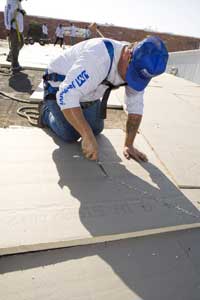view all Case Studies
Hail Resistance Key to Selecting Roof System

The Maury County School District in Columbia, Tenn., had to replace numerous roofs that received multiple applications and repairs during the past 20 years. The area had sustained a considerable amount of hail, and the original roofing systems, which were installed without a cover board, had been damaged substantially over time.
January 31, 2008 -
Roofing
The Maury County School District in Columbia, Tenn., had to replace numerous roofs that received multiple applications and repairs during the past 20 years. The area had sustained a considerable amount of hail, and the original roofing systems, which were installed without a cover board, had been damaged substantially over time.
“The hail had been so severe at some locations that the damage penetrated the roof membrane,” says Matt Fell, senior architect and shareholder at SSOE Inc. “Johns Manville’s Invinsa™ roof board was presented to me as a possible cover board for the new system to protect the roofs from hail damage. Invinsa had the right density and characteristics for absorbing impacts, as well as the added benefit of being lightweight for ease of installation.”
The roofing-contractor crew felt Invinsa enhanced the application of the system, due to its ease of use.
“Invinsa is considerably lighter than other cover boards, so you don’t need as much manpower or equipment,” says Keith Stiles, vice president of Maxwell Roofing. “Unlike other alternatives, Invinsa is easy to score and snap, so there’s almost no debris or residue.”
Fell accepted a substitute system for the 130,000-square-foot replacement roof on Columbia Central High School. The system consisted of mechanically fastened, tapered, and non-tapered JM ENRGY 3® polyisocyanurate insulation, followed by Invinsa roof board and a fully adhered JM PVC-60 SR membrane.
Fell says with the Johns Manville system, he was able to obtain a good R-value and reflectivity, as well as a 20-year, full-system warranty from one manufacturer. Fell says he likes using Polyvinyl chloride (PVC) on schools because of minimal installation odor and the ease of maintenance and repair.
Columbia High School’s roof replacement was part of a major reroofing project on a number of district schools built in the early 1960s. Maxwell Roofing installed roofing systems on two other district schools in early 2007, and the company installed an additional 60,000 square feet of the same roofing specification toward the end of 2007.
“The biggest challenges of the job were the schedule and the logistics of working at a school,” Stiles says. “There were six different roof areas at four different elevations, with the smallest being 13,000 square feet and the largest at 35,000 square feet. We had to move around quite a bit. We were careful not to disrupt classes, and we stored our materials so they would not be of danger to students.”
Next
Read next on FacilitiesNet












